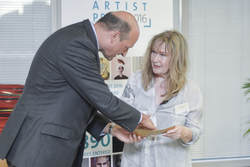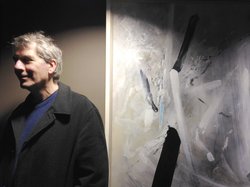|
Our 2nd talk in the Ashurst Emerging Artist Prize 2018 series sees some of our previous shortlist and winners join us to talk about where they are now and how they’ve maximised opportunities to get there. Below we’ve written up this advice and discussion covering:
FIRST TO BRIEFLY INTRODUCE OUR SPEAKERS:  Maureen Jordan – Sculpture Prize Winner 2016. Maureen was our first Sculpture Prize Winner. She recently held her first solo show, alongside Folkestone Triennial, displaying new work and is looking towards residencies next year both in the UK and abroad. See more of her work at https://www.mvjordan.com/  Brad Kenney – Shortlisted Artist 2016. Brad’s practice is centred on painting, since graduating from his Masters in Fine Art from Chichester University he has sold work and exhibited internationally. His exhibition calendar is already filling up for 2018 and 2019. See more of his work at https://www.bradkennystudio.com/  Bob Aldous – Shortlisted Artist 2015. Bob is an Abstract painter and poet. Since his shortlisting in 2015 he has become represented by Gray Modern & Contemporary Art and Cricket Fine Art. He has exhibited several times at The Other Art Fair and the London Art Fair and has also shown work at LAPADA. His most recent success was a solo show at One Paved Court Wimbledon. See more of his work at http://bobaldous.com/ QUESTIONS TO THE ARTISTS:
What point would you say you’re at now in your careers and how did you get there? BOB: Now represented after talking to a dealer at London Art Fair in 2015 who came down to The Other Art Fair and loved my work. London Art Fair then featured my work on their social media – instagram – and that led to a Chelsea based dealer getting in touch. Right now, although I’m technically represented I still very much feel like I am self-representing a lot but this combination works. Talking to people has been paramount to where I am now. BRAD: I graduated from my MA in 2015 and made the decision to work part time and spend the rest of my time in the studio, I did lots of applications for opportunities all over the country and a year later I decided to give it a go working as a full time artist. Now, I am slowly making more steady sales and commissions, I run a monthly workshop which has been good at spurring on my own creativity to make work. MAUREEN: Despite being a ‘mature’ artist I am still very much an emerging one. I feel like I am now getting into my stride not just after winning the 2016 Sculpture Prize with the Ashurst Emerging Artist Prize but also holding a solo show under my own volition during Folkestone Triennial – it’s really never too early in a career to try this I don’t think. What has been important is more consistently making new work, it has increased my confidence in what I am doing and helped me refine my practice more. What do you consider your top successes to date? MAUREEN: My solo show in Folkestone, because it was a challenge to put myself and my new work out there for feedback whatever it may be in such a vulnerable way. I’ve also secured a residency in Vermont, initially I thought there must not have been too many applications but when I asked it turned out there were 1200 and 50 were shortlisted so to be selected knowing that was a big confidence boost. BOB: Definitely when my work went to LAPADA with a dealer that was a break through moment. It came at a point when I really needed it, not just because the value of my work went up – this is definitely not the only measure of success – but because of the validation it offered. BRAD: Getting my work into London was an important success. And also my second solo show which I held in an art store. Not because I had to produce the work but in this instance I had to curate, install, market and invite everyone down and this was a new and valuable skillset to learn. How do you choose the right opportunities to apply to? BRAD: I find opportunities via newsletters, looking online and word of mouth. I then do lots of research. I look at the kind of image the opportunity presents, what artists have the shown previously, what tone do they present, what location are they in and do these things add up to suit me and my goals. MAUREEN: I used to apply for everything but soon learnt this wasn’t necessarily the most helpful way to do things! I now look a lot for paid opportunities so I am not paying out – often opportunities which don’t have a monetary benefit don’t take into account costs like materials, time, travel, etc., that the artist may have to pay out to take part. If the opportunity isn’t paid then are the benefits worth it to develop my practice. For example, a residency I have coming up in a woods isn’t paid but it is worthwhile – its near where I live, offers me the chance to extend work I’ve done previously, is alongside other artists so will give me peer interaction and involves a symposium and catalogue so, exposure. Always bring it back to what the benefits are to you as an artist. Have you ever turned down an opportunity? BOB: Yes a number of them! Usually because the cost is too high. It’s always worth remembering that being an emerging artist means you are a market and there are opportunities out there that are driven by wanting your money and not benefitting your career. Remember to research so you can decipher which ones are worth possibly paying for and which aren’t and don’t be afraid to contact opportunities directly or other artists who have done them before and can possibly shed light on whether they are beneficial. AUDIENCE Q & A: What were you ‘break through’ moments? MAUREEN: Winning the Sculpture Prize with the Ashurst Emerging Artist Prize in 2016 was definitely one. It gave me confidence and validation that I was on the right path which was very motivating to keep going. Do you feel there are more opportunities in London and that is where to look? BRAD: There is more of course, it’s the capital and a hub for the arts so naturally there will be more opportunities. But that doesn’t mean you stop looking elsewhere, I still apply to opportunities all over the country as it will open up new audiences to my work and can be just as beneficial. You just have to make sure again that you research the opportunity and make sure it is right for you. What tips do you have on approaching galleries? BOB: We all know it’s a big no-no to approach galleries at art fairs but I ended up getting talking to a dealer at London Art Fair, it turned out we had someone in common and the connection grew from there. I invited them to a few things including The Other Art Fair which they came to and it grew quite organically from there. The opportunity came more from talking to people and being present in the wider art world. BRAD: One thing a gallerist told me was that a number of artists approached him but didn’t know anything about the gallery. If you’re emailing a gallery demonstrate you know a bit about them so it doesn’t look like a generic mail out or is a waste of their time. If your work doesn’t fit, don’t approach. One other thing I think is a good idea is to look at what is around a gallery – pubs, restaurants, cafes etc. Maybe see if they’ll put your work up and see if you can attract the gallery staff to come and have a look. Rather than approaching a gallery you need to place yourself in their way. Do you have any tips on gaining exposure via social media? CONRAD: Yes! We have a blog on our website where we talk about this and offer our top tips, see it here: http://www.artprize.co.uk/blog-articles/how-to-promote-yourself-1 Where do Art Consultants find Artists? CONRAD: As a Consultant I used to go via word of mouth and visiting art fairs and group exhibitions. Now I more often use the database of artists we have through the prize. We keep all the entry forms and artists details and if a client is looking for something specific we can look through our Instagram feed – we post every entrant on there – to find a work or artist that fits what they are looking for then link it back to the application and get in touch! Do you have contracts or agreements in place so if you sell a work you can still use it in exhibitions or for opportunities? If yes how do you do this? BRAD: Usually I discuss this on a case by case basis with a collector, most are happy to oblige if it means the work or me as the artist is doing well – every step stone of success adds value and provenance to the work they now own after all. However, just be aware that if you’re reusing a work that you will be responsible for any costs incurred not the collector. CONCLUSION: We asked our Speakers to summarise their best advice for Emerging Artists, here it is: BRAD:
MAUREEN:
BOB:
Our next talk is coming up on the 17th January at Ashurst entitled How to Grow Your Art Career. You can read more or RSVP via this link: www.artprize.co.uk/events
2 Comments
4/1/2018 11:35:58
Very informative and encouraging to stick with it. Being an artist is definitely a way of life rather than a job. The advice on making sure the backs of the paintings look professional was something I'd never considered before so thank you.
Reply
23/1/2018 14:57:42
Interesting comment from Brad about 'lifestyle' not 'career', which I very much agree with but I also think it's important to nurture other ways to engage with the world, so that one can return to artwork refreshed and re-focused. I've found, over time, that my best work happens when i've spent a short period of time away from the coalface - even if it's just a couple of days. That doesn't make one any less dedicated; it's simply finding a way of working that best suits one's practice. I wonder what approach other artists take?
Reply
Your comment will be posted after it is approved.
Leave a Reply. |
Oaktree & Tiger TeamArt experts giving advice to emerging artists to build their careers and find success. Organisers of the Ashurst Emerging Artist Prize 2020, artist agent and art consultants. Archives
December 2019
Categories
All
|
|
Ashurst Emerging Artist Prize 2021
Address: Ashurst, London Fruit & Wool Exchange, Duval Square, London E1 6PW, UK Email: [email protected] Website: www.artprize.co.uk Managed by Oaktree & Tiger |
|
Subscribe to receive updates and invites...
© 2014 - 2021 All Rights Reserved
|

 RSS Feed
RSS Feed